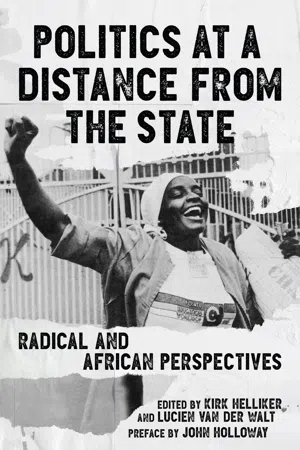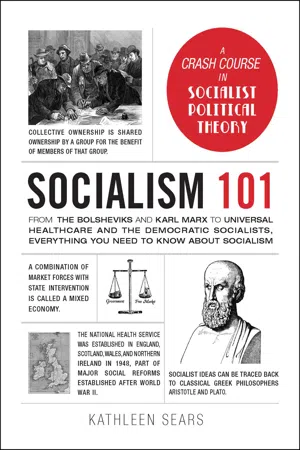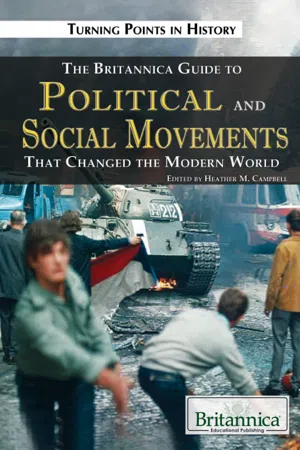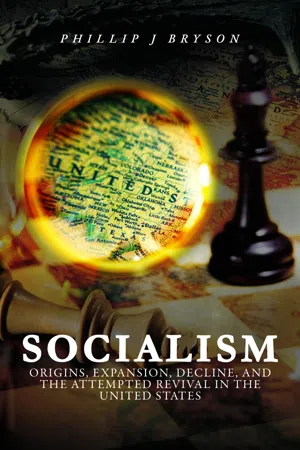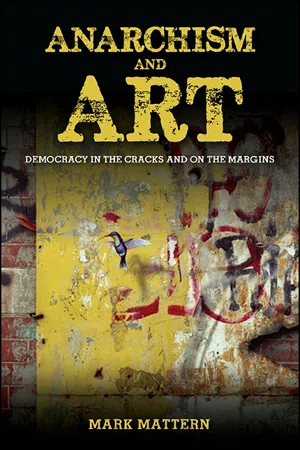Politics & International Relations
Anarcho-Syndicalism
Anarcho-syndicalism is a political theory that advocates for the organization of society through decentralized, worker-controlled trade unions. It seeks to abolish the state and capitalism, and instead promote a system of direct action, solidarity, and self-management. Anarcho-syndicalists aim to create a society based on voluntary cooperation and mutual aid, with a focus on workers' rights and economic equality.
Written by Perlego with AI-assistance
5 Key excerpts on "Anarcho-Syndicalism"
Learn about this page
Index pages curate the most relevant extracts from our library of academic textbooks. They’ve been created using an in-house natural language model (NLM), each adding context and meaning to key research topics.
- eBook - ePub
Politics at a Distance from the State
Radical and African Perspectives
- Lucien van der Walt, Kirk Helliker(Authors)
- 2022(Publication Date)
- PM Press(Publisher)
The contemporary movement draws upon – albeit in uneven ways – a rich body of theory and practice in labour, left, anti-imperialist, anti-colonial and equal rights movements that goes back to the 1860s. This includes a significant history in northern and southern Africa (e.g. Hirsch and van der Walt 2014). It is often forgotten that mass, organised anarchist and syndicalist movements, some stronger than their Marxist and nationalist rivals, were common into the 1950s. Anderson reminded us anarchism was once the ‘dominant element in the self-consciously internationalist radical Left’, and ‘the main vehicle of global opposition to industrial capitalism, autocracy, latifundism, and imperialism’ (Anderson 2006, 2, 54). It is simply not possible to adequately understand the history of, for instance, unions and rural struggles in Latin America, or peasant and anti-imperialist struggles in East Asia, or anti-colonial and anti-racist movements in southern Africa, or labour and the left in Europe, without taking anarchism and syndicalism seriously (van der Walt 2011).This paper examines the breadth, impact and insights of anarchism/syndicalism, and its possible relevance to twenty-first-century labour, left and national liberation movements. In doing so, it unpacks the core ideas, social critique, transformative vision and strategy of anarchism/syndicalism. It pays especial attention to its views on classes, state power, equality and emancipation and its critique of statist models like Marxism and nationalism. Finally, the paper examines some important challenges anarchism/syndicalism need to address, in order to consolidate and expand.What is anarchism? And syndicalism?
It is essential, first, to reject the ‘assumption that revolutionary Socialism is … covered by the term “Marxism-Leninism”’ (Schechter 1994, 1–2), and ‘recall anarchism, which Leninist Marxism suppressed’, and the ‘democratic ideals’ for which it ‘served as a repository’ (Dirlik 1991, 3–4, 7–8). Here, is necessary to reject some common misunderstandings. A long tradition defines anarchism as an ideology opposed to the state (e.g. Engels 1972, 71; Shatz 1971, xiii). But this is not very helpful. Classical Marxism also insisted that the state ‘wither a way’ (Lenin 1975, 257, 281; Mao 1971, 372; Marx and Engels 1954, 56–57; Stalin 1942:468473). Liberalism too was antipathetic to the state, arguing for free markets as means of limiting state power (e.g. Friedman 1982, 23–36; Von Hayek 1944, 14–16, 52–57). - eBook - ePub
Socialism 101
From the Bolsheviks and Karl Marx to Universal Healthcare and the Democratic Socialists, Everything You Need to Know about Socialism
- Kathleen Sears(Author)
- 2019(Publication Date)
- Adams Media(Publisher)
SYNDICALISM AND TRADE UNIONS Strike! Strike!Social democrats weren’t the only socialists to reject Marxist orthodoxy. Standing at the intersection between trade unionism and anarchism, syndicalists believed that Marxism simply replaced capitalist factory owners with state bureaucrats. They also rejected social democracy’s efforts at working within the system. Caught between state oppression and the futility of politics, syndicalists believed that society could be transformed only through direct action by the working classes themselves, using trade unions and the general strike as their tools.WHAT IS SYNDICALISM?
Syndicalism was a militant form of trade unionism that combined the ideas of Marx, Proudhon, and Bakunin with the technique of collective action by workers. Syndicalists advocated workers taking over the means of the production as a first step in abolishing the state. Both the state and the capitalist system would be replaced by a new social order, with the local trade union as its basic unit of organization. The method generally favored for accomplishing this transformation was the general strike.Syndicalists rejected social democracy’s policy of reform through parliamentary politics and Marxism’s reliance on a centralized state after the revolution. Political parties were incapable of producing fundamental change. The state was by its nature a tool of capitalist oppression.Instead of reform or state socialism, syndicalists looked to revolution by the direct action of the workers. If the unions were not strong enough to risk a strike, their members would attack employers through boycotts and sabotage. The climax of direct action would be the general strike.After the revolution a federation of trade unions and labor exchanges would replace the state. Trade Union or Revolutionary Movement?The word syndicalism comes from the French term for labor union: syndicate (not to be confused with the English syndicate , which is something totally different). In France, where the movement was born, syndicalism means plain vanilla trade unionism. In France the union-based socialist movement is called revolutionary syndicalism or Anarcho-Syndicalism - eBook - ePub
- Britannica Educational Publishing, Heather Campbell(Authors)
- 2009(Publication Date)
- Britannica Educational Publishing(Publisher)
bourses du travail was formed, and by 1895 a group of anarchists, led by Fernand Pelloutier, Émile Pouget, and Paul Delesalle, had gained effective control of the organization and were developing the theory and practice of working-class activism later known as Anarcho-Syndicalism, or revolutionary syndicalism.The anarcho-syndicalists argued that the traditional function of trade unions—to struggle for better wages and working conditions—was not enough. The unions should become militant organizations dedicated to the destruction of capitalism and the state. They should aim to take over factories and utilities, which would then be operated by the workers. In this way the union or syndicate would have a double function—as an organ of struggle within the existing political system and as an organ of administration after the revolution. The anarcho-syndicalists’ strategy called for sustaining militancy by creating an atmosphere of incessant conflict, which would culminate in a massive general strike. Many anarcho-syndicalists believed that such an overwhelming act of noncooperation would bring about what they called “the revolution of folded arms,” resulting in the collapse of the state and the capitalist system. However, although partial general strikes, with limited objectives, were undertaken in France and elsewhere with varying success, the millennial general strike aimed at overthrowing the social order in a single blow was never attempted. Nevertheless, the anarcho-syndicalists acquired great prestige among the workers of France—and later of Spain and Italy—because of their generally tough-minded attitude at a time when working conditions were bad and employers tended to respond brutally to union activity. After the General Confederation of Labour (Confédération Générale du Travail; CGT), the great French trade-union organization, was founded in 1902, the militancy of the anarcho-syndicalists enabled them to retain control of the organization until 1908 and to wield considerable influence on its activities until after World War I (1914–18). - eBook - ePub
Socialism
Origins, Expansion, Decline, and the Attempted Revival in the United States
- Phillip Bryson(Author)
- 2021(Publication Date)
- PageTurner Press and Media(Publisher)
In any case, anarchism seeks to combine communal ownership with a state possessing the least possible power. It is apparent that anarchism is the extreme left wing of the Socialist movement. As Marx is viewed by Russell as the founder of modern Socialism, Mikhail Bakunin (1814-1876) is seen as the founder of Anarchist Communism. Since Bakunin did not create a complete, systematic body of doctrine as Marx did, one must turn to the writings of Bakunin’s follower, Peter Kropotkin (1842-1921), to find the complete body of thought. We have not time here to review it, but the tale is told in a captivating manner by Bertrand Russell.By the early 1900s we see Anarchism actually a part of the political reality of France. Socialism was thriving there, but as factions including Anarchism and Syndicalism. Contention among Socialists caused difficulties in the Trade Unions and led to an agreement to keep politics out of the Unions. According to the Russell narrative, it was a rather easy step from the point of this agreement to a viable situation for Syndicalism.Syndicalism is based more on the perspective of the producer than of the consumer, being concerned with reforming actual work processes and practices, together with the organization of industry. More orthodox socialism has greater concern for securing greater rewards for work. Anarchism aspires to substitute industrial for political action, and at using Trade Union organization to accomplish things for which orthodox Socialism would turn to Parliament and government action. The response of socialists in France and the Latin nations was generally far more positive to the doctrines of Bakunin and Kropotkin, opposing the State and disbelieving in the machinery of representative government. The conflict between the two groups was often quite bitter early in the 20th century.Part II: Utopian SocialismGeorge Douglas Howard Cole (1889-1959) was a noted Professor of Social and Political Theory at University College, Oxford. A Fabian socialist, he authored several historical and economic works, including a multi-volume work on the early history of the Soviet Union and a voluminous collection A History of Socialist Thought . In the latter, he emphasized at the outset how difficult it is to find a definition of socialism that is generally accepted. He explained that this should not be seen as a reproach, since neither in politics nor morals are ideas or systems of importance capable of being defined exactly. Democracy, liberty, virtue, the state, happiness, individualism – all are a challenge for the analyst.93 - eBook - ePub
Anarchism and Art
Democracy in the Cracks and on the Margins
- Mark Mattern(Author)
- 2016(Publication Date)
- SUNY Press(Publisher)
For both anarchists and participatory democrats, the principle of decentralization helps avoid concentrations of power that allow domination, offering more capacity to control the circumstances of one’s own life. Nonhierarchical, horizontal authority similarly broadens and deepens the capacity of individuals and groups to exercise autonomous choice and effective action by avoiding the dominating effects of powerful figures and institutionalized representatives in positions of control. A rhizomatic structure prevents the centralization of power and consequent threats to freedom. Direct participation ensures that each person has a voice and a direct role in decision-making, and helps block the exercise of domination by some over others.Political Action
To accomplish their goals, anarchists have long advocated a strategy of direct action. Bakunin, for example, advocated a social revolution in the form of spontaneous uprisings devoid of institutionalized leaders or a priori goals other than liberation. To speed along this social revolution, he proposed “propaganda of the deed.” Bakunin argued that “we must spread our principles, not with words but with deeds, for this is the most popular, the most potent, and the most irresistible form of propaganda.”23 Initially, propaganda of the deed carried overtones of violence against both property and people; most contemporary anarchists disavow it as violence against people, while some continue to advocate minor property vandalism.Anarchists reject the strategy of seizing the state, even if temporarily. Instead, earlier anarchists emphasized labor organizing and general strikes favored by anarcho-syndicalists, leading to civil disobedience, guerrilla warfare, and hopefully the collapse of the state. Given the failure of these strategies to seriously challenge state and capitalist domination, more recent anarchists entertain visions of partial anarchy, or anarchy that exists within the cracks and on the margins of state and capitalism. They take their inspiration in part from Gustav Landauer (1870–1919).24 Landauer was skeptical about the possibility of radically transforming state-capitalist societies either by revolution or by slow reform, in part because “the masses” could not be relied upon to instigate, or even support, change. He advocated creating new institutions alongside, rather than inside or atop, existing institutions. Landauer’s strategy thus entails a willingness to coexist with these larger structures of domination, while striving to avoid contributing positive energy to them. It suggests creating alternative ways of living in the present rather than awaiting a time ripe for large-scale revolutionary change. As contemporary anarchist Richard Day put it, “there is no choice for those of us who desire to live differently but to begin to do so ourselves.”25
